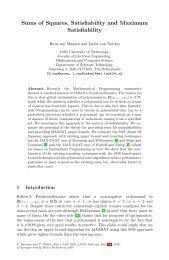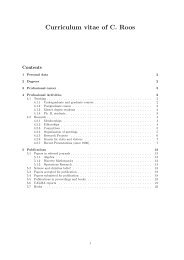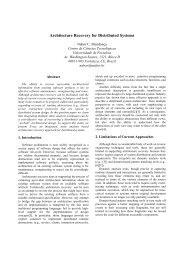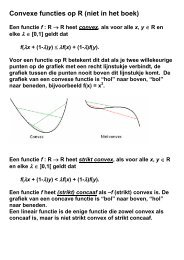Full-Newton step polynomial-time methods for LO based on locally ...
Full-Newton step polynomial-time methods for LO based on locally ...
Full-Newton step polynomial-time methods for LO based on locally ...
Create successful ePaper yourself
Turn your PDF publications into a flip-book with our unique Google optimized e-Paper software.
Proof of Theorem 4 (1)We first c<strong>on</strong>sider the case where n = 1. Then that κ = κ(x, s) is defined by2κ = maxh,kSubstitutingget⎧⎪⎨⎪⎩∣ ϕ ′′′ (0) ∣ ∣(ϕ ′′ (0)) 3 2=∣ 1 4[ψ′′′2 √ 2 κ = maxy,zb (v) v2 (h + k) 2 − 3 ξ(v) v (h − k) 2] v (h + k)[ [ 12 ψ′′b (v) v2 (h + k) 2 − ψb ′ (v) v (h − k)2]]3 2y = h + k, z = h − k,[ ∣ ψ′′′b (v) v2 y 2 − 3 ξ(v) vz 2] vy[ψ′′b (v) v2 y 2 − ψb ′ (v) vz2]3 2The last expressi<strong>on</strong> is homogeneous in (y, z). It follows that2 √ 2 κ = max {∣ [∣ ψ′′′b (v) v2 y 2 − 3 ξ(v) vz 2] vy∣ : ψ b ′′ (v) v2 y 2 − ψ b ′ (v) vz2 = 1 } .Be<str<strong>on</strong>g>for</str<strong>on</strong>g>e proceeding we recall the definiti<strong>on</strong>s of ρ(t) and ¯ρ(t):Note that ¯ρ(t) ∈ (0,2].∣ρ(t) = ψ′ b(t) ψ′′′b (t)ξ(t)ψ ′′ , ¯ρ(t) = min[2, ρ(t)] . (10)(t)b∣.29⎫∣⎪⎬⎪⎭.
















